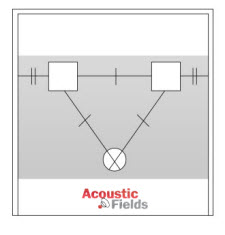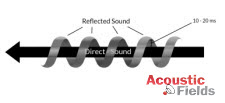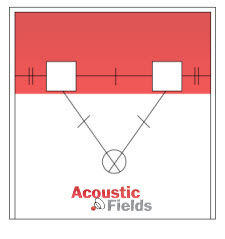It’s the time of year for saving money!
As we discussed in our “6 ‘Do’s’ When Setting Up Your Hi-Fi System,” there are certain things you must do in order to get the most out of your two-channel audio system. Your goal is a soundstage with width, height and depth that extends past all the physical objects that are needed to produce the energy. We want to get as close to sounding like the actual event or even better. It is a sound that has the correct balance of gear energy and room sound. There are certain must-have elements to this relationship of room, gear and human hearing systems in order to achieve this noble sonic goal … and there are some things that you simply cannot do at all. That’s what we’re here to discuss today.
 1. Don’t Interrupt the Sound Triangle
1. Don’t Interrupt the Sound Triangle
Our sound triangle, or the triangle formed with our speakers and listening position as its apexes, must not have anything placed to the left or right of it. The space inside of the sound triangle and surrounding side areas can not have equipment racks, chairs, end tables, lights, ottomans or sofas. Enough examples, you get the idea. This is sacred ground. Any object that creates spurious reflections in this area must go. Reflections from room walls and other objects within the room, along with sound pressure are the two most important variables we must manage correctly. Respect this and you have a great beginning towards your final goal.
2. Don’t Allow Unequal Side Wall Distances
Along with this issue, you must make sure both speaker-to-side-wall distances are of equal length. The left speaker can not sit 3 feet away from the side wall and the right speaker 4 feet away. Sound moves at a constant speed and we need to be able to capitalize on that constant. With unequal distances, we have time-delayed reflections that are reaching both left and right ears, one side with its own time signature based upon a certain distance and the other side with a different time signature caused by the different distance to the wall. This causes image shifting, some loss of center image focus, and lessening of “air” or spaciousness in our sonic presentation. Let’s keep those speaker-to-side-wall distances equal.
3. Don’t Get the Balance Between Reflections and Direct Sound Wrong
 The sound you hear in your listening chair must have the correct blend of direct sound from the speakers (straight line) and reflections from side walls in order to establish a solid center image and a broad, deep soundstage. This direct/reflected sound ratio operates in a very small time window of 10 to 20 milliseconds. The time signature of the side wall reflection must reach your ears within 10 to 20 ms. after the direct sound from the speakers reaches your ears. If you have a larger delay, you have image smearing, reduction in clarity or definition, and lack of image focus. Shorter delays create a nearfield effect, with more direct energy from the speakers, which will reduce the room reflections and ambience. Side wall treatments must be uniform in rates and levels of either absorption or diffusion technologies.
The sound you hear in your listening chair must have the correct blend of direct sound from the speakers (straight line) and reflections from side walls in order to establish a solid center image and a broad, deep soundstage. This direct/reflected sound ratio operates in a very small time window of 10 to 20 milliseconds. The time signature of the side wall reflection must reach your ears within 10 to 20 ms. after the direct sound from the speakers reaches your ears. If you have a larger delay, you have image smearing, reduction in clarity or definition, and lack of image focus. Shorter delays create a nearfield effect, with more direct energy from the speakers, which will reduce the room reflections and ambience. Side wall treatments must be uniform in rates and levels of either absorption or diffusion technologies.
4. Don’t Live With Room Openings
Make sure you have no side wall openings or recessed areas in the sound triangle. The side wall surfaces should be as uniform and consistent as possible. This compatibility must occur from speaker to listening position. Even the density of each side wall should be equal. This is serious stuff in order to achieve a strong and well-focused center image with large separation and gobs of definition. Composition and density are factors because sound takes on some the characteristics of the surfaces that it strikes. Openings, just like unequal side wall distances, change the time signature of reflections. Delay one side relative to the other and your stereo imaging suffers along with spaciousness and instrument and vocal separation.
5. Don’t Live With Glass — No, None, Never
In today’s living/listening rooms, there is glass everywhere. I do not know how this came to be, but there are windows, cabinets, vases, even coffee tables with glass tops. I’ve measured “glass response,” and I can assure you its impact on frequency response is anything but favorable. All glass surface areas are to be avoided. If you can’t get rid of the glass, it must at least be covered with sound absorption or diffusion technology. Please cover it with something that will prevent energy from striking it and then reflected back into the total room sound.
6. Don’t Use the Wrong Treatment
 Make sure you use the correct sound absorption and diffusion technology for your front wall area. I’ve seen a lot of confusion here. This is an area of high pressure, and technologies that are pressure-reactive work best here. Foam is not found in this family. Neither are boxes filled with building insulation. You must choose from three types: membrane, diaphragmatic, or Helmholtz. Each is similar in design and function, but they have drastically different performance parameters. Make sure you use the one that can achieve the performance required in this high-pressure area and has the acoustical horsepower to absorb at the needed rates and levels the unwanted front wall pressure area requires.
Make sure you use the correct sound absorption and diffusion technology for your front wall area. I’ve seen a lot of confusion here. This is an area of high pressure, and technologies that are pressure-reactive work best here. Foam is not found in this family. Neither are boxes filled with building insulation. You must choose from three types: membrane, diaphragmatic, or Helmholtz. Each is similar in design and function, but they have drastically different performance parameters. Make sure you use the one that can achieve the performance required in this high-pressure area and has the acoustical horsepower to absorb at the needed rates and levels the unwanted front wall pressure area requires.
The Necessity of Coexistence
Usually, our hi-fi systems must fit into another room that has living, however that is defined today, as its objective. Our living/listening rooms must serve many masters. How do we live and still listen to our music in an environment that allows us to hear stereo correctly? We can do both if we do and don’t do some basic acoustical things. If we don’t put anything into the sound triangle, we make sure all speaker/side wall distances are equal along with similar composition and density, acoustically treat the side walls with uniform treatment, stay away from openings and alcoves, get rid of all glass surfaces and then control front room pressure with the proper rates and levels of acoustical tools, we are on our way. Now, if we could just get rid of that “living” part and make it all listening.





